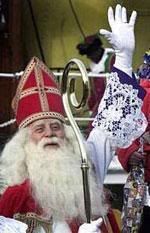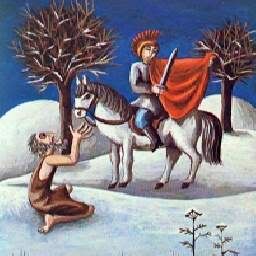That day, November 11th, is also Martinmas, the nameday of St Martin, patron saint of travellers and children. He is credited with handing his cloak to a beggar, when the latter had nothing (see tag below). Up until recently, children in Holland, Flanders and Germany would go round the streets in the evening of 11th November, carrying paper lanterns.
Today, I am informed, Sinterklaas (St Nicholas) has made his formal entry in the Netherlands. His nameday is December 6th, but that in itself is not observed. It is rather the eve of his nameday, 5th December, which is sees a lot of festivities in Holland, Flanders and Germany.
St Nicholas was bishop of Myra (present-day Smyrna in Turkey). After his death, his bones were interred in Myra, but when the Muslims conquered Turkey, Nicholas's bones were spirited across the Mediterranean to Spain.
 It is from there (the legend goes) that he sails north in November in a steamship with a possy of Black Peters as his helpers. Black Peter, a reference to the Moors [North Africans] that once ruled Spain, is a bogeyman figure, as children are threatened that he will take them back to Spain if they misbehave. And all their misdemeanours are entered in St Nicholas's big book. The saint rides the streets of Holland on his white charger, with the Black Peters throwing sweeties around. At night, he rides the rooftops and throws presents down the chimneys. At the bottom of said chimneys, the children will have put out a shoe with a carrot for the horse; which will be substituted by a present from St Nicholas in the morning.
It is from there (the legend goes) that he sails north in November in a steamship with a possy of Black Peters as his helpers. Black Peter, a reference to the Moors [North Africans] that once ruled Spain, is a bogeyman figure, as children are threatened that he will take them back to Spain if they misbehave. And all their misdemeanours are entered in St Nicholas's big book. The saint rides the streets of Holland on his white charger, with the Black Peters throwing sweeties around. At night, he rides the rooftops and throws presents down the chimneys. At the bottom of said chimneys, the children will have put out a shoe with a carrot for the horse; which will be substituted by a present from St Nicholas in the morning.By the age of 8, children are usually told the truth of St Nicholas, and the set-up changes. Lots are drawn in families for presents to be bought for one other family members. This is then wrapped in a surprise wrapper. Our family tradition of hiding the presents and leaving instructions to the hiding place was abandoned, as the giver of one present forgot where they had hidden their present - and it is still in that forgotten location, more than 35 years later...
I would like to point out that Sinterklaas or St Nicholas has been corrupted to Santa Klaus in the Anglo-Saxon world (of UK and USA). The notion of Father Christmas is held with derision in Holland, although he has been embraced by the commercially minded. I shudder to remember the unedifying spectacle of Father Christmas and Sinterklaas coming to blows in the centre of one Dutch city, some years ago.

No comments:
Post a Comment